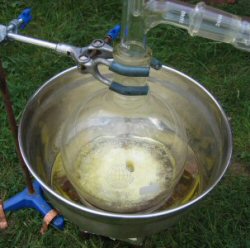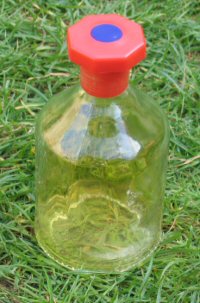 | Under heavy construction. |
Nitric Acid (HNO3)

Nitric acid is a strong acid which is best known for its use in explosives such as nitroglycerin and TNT. But that's not to say that it's limited purely to explosive compounds, for it also finds extensive uses in areas such as fertillizers and metallurgy.
It can be difficult to obtain nitric acid from commercial sources. Even if you find a source who are allowed to, and are willing to sell it to you, it will often be of a low concentration and very expensive. Luckily though, nitric acid can be distilled from easily obtained chemicals. It's also a lot more fun to distill chemicals yourself.
Nitric acid can be divided into 2 basic groups: fuming nitric acid and non-fuming nitric acid. Fuming nitric acid, so called because it gives of fumes, has the highest concentration and can be further sub-divided into red fuming nitric acid and white fuming nitric acid. Red fuming nitric acid is the highest concentration possible.
This page shows my results in vacuum distilling nitric acid.
Chemicals
In the following experiments I'm reacting KNO3 (LR Grade) and H2SO4 (98% LR Grade) to obtain K2SO4 and HNO3.2KNO3(s) + H2SO4(l) --> K2SO4(s) + 2HNO3(l)
Using the atomic weights we can stoichiometrically work out what quantities to use and what quantities to expect.
| Element | Atomic Weight |
| K | 39.10 alu |
| N | 14.01 alu |
| O | 16.00 alu |
| H | 1.01 alu |
| S | 32.07 alu |
Reactants
2KNO3 = 2 * (39.10 + 14.01 + (3 * 16.00)) = 202.22 g/mol (67.34%)
H2SO4 = (2 * 1.01) + 32.07 + (4 * 16.00) = 98.09 g/mol (32.66%)
Products
K2SO4 = (2 * 39.10) + 32.07 + (4 * 16.00) = 174.27 g/mol (58.03%)
2HNO3 = 2 * (1.01 + 14.01 + (3 * 16.00)) = 126.04 g/mol (51.97%)
The following table shows the density of the concentrated liquids.
| Molecule | Density |
| H2SO4 | 1.84 g/cm3 |
| HNO3 | 1580 kg/m3 |
More to come soon...
Equipment
The following image shows my setup (excluding thermometer).

In the above image you can see the following items (from left to right):
 Alcohol Burner
Alcohol Burner
 Oil Bath
Oil Bath
 2L Boiling Flask
2L Boiling Flask
 Leibig Condeser
Leibig Condeser
 1L Receiver Flask
1L Receiver Flask
 Ice Bath
Ice Bath
 Water Trap
Water Trap
 Aspirator
Aspirator
 Water Pump (4 BAR)
Water Pump (4 BAR)
 Water Resevoir
Water Resevoir
For lack of a hotplate I have to resort to heating stuff with a flame (see the safety points). I strongly advise against heating the boiling flask directly with an open flame as it causes uneven heating and can seriously stress the glass. Instead the flame heats an oil bath which inturn heats the boiling flask. The oil bath provides more even heating at a lower temperature. A lower temperature is generally more desirable in vacuum distillation. Also, when the heat is removed the oil slowly cools down which is quite important when dealing with vacuum glassware. If you cool vacuum glassware too quickly it can over stress it.
During vacuum distillation large gas bubbles can form in the boiling flasks solution. These bubbles rise to the top of the solution and violently burst. This is called bumping and it's very undesirable as it can send the liquid solution into the condeser as well as violently shaking the apperatus. Ideally you would use a magnetic stirrer to prevent the bumping, but as I don't have access to one I've opted to use bits of non-glazed porous clay in the boiling flask.
The receiver flask is put in an ice bath to further help cool any gas which may have passed through the condeser.
The vacuum is pulled by an aspirator which is connected to a high powered water pump. The water is circulated through the pump into the aspirator and then out of the aspirator into the condenser. Finally the water is pumped out of the condenser back into the reservoir.
The plumbing fixtures on the pump had to be bodged together as the pump uses 32mm connectors. I couldn't find any suitable parts to fit the connectors so I had to sand 32mm pipe down to size and then force it into the threaded holes. The tap was attached to copper pipe which was in turn connected to a modified pipe end. Sealing the unit was difficult due to the high pressure. Silicon sealant was simply pushed out of the way, so I tried a product called No More Nails which was even more useless than the silicon sealant. In the end I found super glue was the most effective at sealing the unit.
Results

For my first try at distilling nitric acid I used 99g of H2SO4 and 134g of KNO3. First of all I put the non-porous clay into the boiling flask (to stop bumping) and then I added the H2SO4 followed by the KNO3. With hind-sight it would have been better to use less clay and to have added it last of all. As I used too much clay it actually formed a pile which rose out of the H2SO4. This meant that a lot of the KNO3 ended up resting on top of the clay and not coming into contact with the H2SO4. I rectified this by adding an extra 150ml of H2SO4 to the boiling flask.
As the H2SO4 and KNO3 hadn't mixed as well as I'd hoped I decided to run the still for only a short period of time . This was only an initial test so I wasn't actually intending on producing large amounts of HNO3 anyway. In the short time the experiment was running I gathered approximately 100 drops of nitric acid. I estimate I was getting around 2 drops every 3 seconds.
During the distillation process the water trap and it's PVC tubing quickly turned a brownish colour (dark red) indicating that nitrious gas was passing through the condenser and receiver flask. Although some gas is expected to pass through I was suprised at just how much was actually getting through. I think totally submerging the receiver flask and its adaptor in an ice bath should help to cool the gas. At the moment the receiver flask is only partially submerged in an ice bath.
The small amount of HNO3 that I gathered fumed heavily. The fumes looked white which is inaccordance with the expected white fuming nitric acid. Originally the HNO3 was a clear liquid, but I left it out in the sun for half an hour and it decompossed into a yellowish liquid and gas (NO2???). It's important to note that HNO3 is light sensitive.
Anyway, although the final yeild was quite small I was actually very pleased with the results. Next time I'll change the order I put the substances into the boiling flask as well as further cooling the receiver flask. I'll also use less anti-bumping clay.
More to come soon...
Tips & Safety Points
 Heating - I use an open flame to heat an oil bath. I strongly advise against heating oil with an open flame as flash overs can easily occur. If you do use an open flame then you should always be ready to deal with any fires. This includes having a suitable fire extinguisher and a fire blanket at your side (both of which are quite cheap). NEVER leave the oil bath unattended and NEVER EVER try and use water to put any oil fires out. The water will sink to the bottom of the oil and quickly turn to steam. The steam will send the burning oil flying all over the place. Instead you should use the fire blanket (or damp cloth) to cover the burning oil and restrict its oxygen supply.
Heating - I use an open flame to heat an oil bath. I strongly advise against heating oil with an open flame as flash overs can easily occur. If you do use an open flame then you should always be ready to deal with any fires. This includes having a suitable fire extinguisher and a fire blanket at your side (both of which are quite cheap). NEVER leave the oil bath unattended and NEVER EVER try and use water to put any oil fires out. The water will sink to the bottom of the oil and quickly turn to steam. The steam will send the burning oil flying all over the place. Instead you should use the fire blanket (or damp cloth) to cover the burning oil and restrict its oxygen supply.
 Vaccum - Even a small vacuum causes a huge amount of pressure to be exerted on the glassware. This pressure can easily cause implosions which will send the glass flying. At a minimum you must ALWAYS wear eye protection. If the glassware has any cracks then it must be replaced straight away.
Vaccum - Even a small vacuum causes a huge amount of pressure to be exerted on the glassware. This pressure can easily cause implosions which will send the glass flying. At a minimum you must ALWAYS wear eye protection. If the glassware has any cracks then it must be replaced straight away.
 Nitric Acid - Needless to say this is a very dangerous acid. With any chemical you should always read the MSDS for the relevant safety issues. This is especially true when dealing with dangerous chemicals. Don't underestimate how dangerous this acid is.
Nitric Acid - Needless to say this is a very dangerous acid. With any chemical you should always read the MSDS for the relevant safety issues. This is especially true when dealing with dangerous chemicals. Don't underestimate how dangerous this acid is.
 Grease - The vacuum will pull the glass joints together. It's vital that you put some grease on the top part of each joint. If you don't use grease you won't be able to get the joints apart. Only a small amount of grease is required on each joint. Twist the joints so as to spread the grease around (before applying the vacuum).
Grease - The vacuum will pull the glass joints together. It's vital that you put some grease on the top part of each joint. If you don't use grease you won't be able to get the joints apart. Only a small amount of grease is required on each joint. Twist the joints so as to spread the grease around (before applying the vacuum).
 Dismantling - While dismantling the still you should remember that nitric acid will still remain in the condenser. Protective gloves are a must.
Dismantling - While dismantling the still you should remember that nitric acid will still remain in the condenser. Protective gloves are a must.
 Fumes - Lot's of toxic fumes are released while dismantling the still. I've breathed some of the fumes in for a brief second and to say they are burning and choking is an understatement. Good ventilation is a must and a gas mask is advised.
Fumes - Lot's of toxic fumes are released while dismantling the still. I've breathed some of the fumes in for a brief second and to say they are burning and choking is an understatement. Good ventilation is a must and a gas mask is advised.
More to come soon...
| Home |